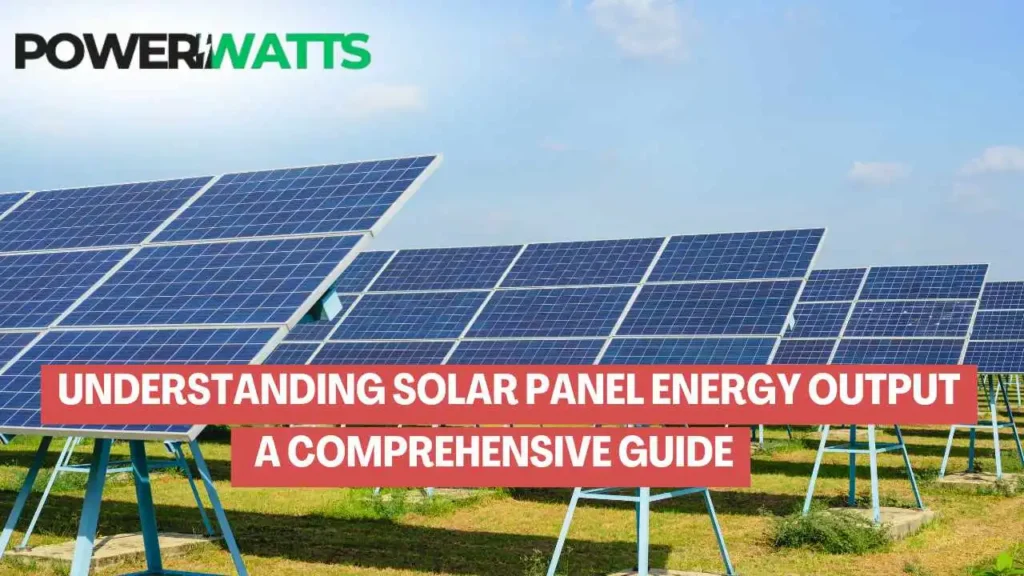Are you interested in how much energy solar panels produce and how that might affect your power bills? This guide will tell you everything you need to know about the things that affect how much energy solar panels produce, so you can make smart choices about your solar energy system. Get ready to use the sun’s power and save as much energy as possible!
What is Solar Panel Energy Output?
Solar panel energy output is the quantity of power created by a solar panel during a certain time period, which is commonly measured in kilowatt-hours (kWh). This output is proportional to the quantity of sunlight that the panel receives and its efficiency in converting that light into usable power.
Factors Influencing Solar Panel Energy Output
1. Solar Irradiance
Solar irradiance, or the quantity of sunlight that reaches the Earth’s surface, plays an important role in determining solar panel energy production. The intensity of sunlight varies with the time of day, season, and location. Solar panels produce more energy in areas with more constant and strong sunshine, such as the southwestern United States.
2. Panel Efficiency
The efficiency of a solar panel indicates how successfully it transforms sunlight into power. Monocrystalline solar panels utilize high-purity silicon and are often the most efficient, with conversion rates ranging from 15% to 22%. Polycrystalline and thin-film solar panels have somewhat lower efficiency, ranging from 13% to 16%.
3. Panel size and Orientation
A solar panel’s size and position relative to the sun influence its energy production. Larger panels with more solar cells create more power, and optimum orientation ensures that the panel gets the most sunshine throughout the day.
4. Temperature
Solar panels are more efficient at colder temperatures, and efficiency decreases as temperature rises. This is because heat causes the solar cells to generate less power and increases the panel’s resistance.
5. Shading
Shading from even a tiny object, such as a tree limb or a chimney, may drastically diminish the energy output of a solar panel. When a portion of a panel is shaded, the affected solar cells generate less power, affecting the overall system’s performance.
Calculating Solar Panel Energy Output
The formula for calculating a solar panel’s energy production is as follows:
- Energy Output (kWh) = Panel Wattage × Peak Sun Hours × Derate Factor
Where:
- Panel Wattage refers to the solar panel’s rated power output in watts (W).
- Peak Sun Hours refer to the amount of hours per day when sunshine intensity surpasses 1,000 watts per square meter (W/m²).
- The Derate Factor compensates for losses caused by variables including temperature, shade, and system inefficiencies.
For a 300-watt solar panel at a location with 5 peak sun hours per day and a derate factor of 0.77, the daily energy production is 1,155 kWh (Energy production = 300 W × 5 hours × 0.77).
Maximizing Solar Panel Energy Output.
To optimize the energy production of your solar panels, consider the following strategies:
1. Choose the right solar panel
Choose a panel with excellent efficiency and a power output that meets your energy requirements.
2. Optimize panel orientation and tilt
Position your panels to get the most sunshine throughout the day, and alter the tilt angle seasonally.
3. Minimize shading
Trim trees regularly and eliminate anything that may create shadows on your solar panels.
4. Monitor system performance.
To ensure peak performance, monitor the energy output of your solar panels and rectify any concerns as soon as possible.
Application of Solar Panel Energy Output To help you comprehend solar panel energy production in real-world circumstances, consider the following examples:
1. Residential Solar System
A typical household solar system has 15-25 solar panels, each with a power output of 300-400 watts. In a location with 5 peak sun hours per day and a derate factor of 0.77, a 20-panel system (6 kW) could produce around 22,000 kWh of power yearly.
2. Commercial Solar System
Depending on the building’s size and energy requirements, a commercial solar system may vary from a few kilowatts to many megawatts. For example, a 500 kW commercial solar system with 1,250 panels (400 watts each) in a region with 6 peak sun hours per day and a derate factor of 0.77 may provide more than 1.3 million kWh of power per year. When considering such installations, it’s important to research the best solar panel companies in California to ensure you’re working with reputable providers who can meet your specific energy needs and deliver efficient, high-quality systems.
Future Trends in Solar Panel Energy Output
As solar technology advances, the energy production of solar panels is expected to increase. Some rising trends are:
- Increased Efficiency Solar cells: Researchers are creating new solar cell materials and designs with more than 25% conversion efficiency.
- Bifacial solar panels: These panels can collect sunlight from all sides, boosting energy production by up to 30 percent.
- Tracking Systems: Solar tracking systems automatically modify the orientation of panels to follow the sun’s movement, resulting in a 20-30% increase in energy production.
Conclusion
Understanding solar panel energy output is critical for reaping the full advantages of solar energy. You can make smart choices about your solar energy system and make sure it works at its best by thinking about things like sun irradiance, panel efficiency, size, direction, temperature, and shade. As solar technology keeps getting better, we can expect even more changes in how much energy solar panels produce. This will make solar energy a more appealing choice for both homes and businesses. If you want to use the sun’s power and save money on your electricity bills, contact us today to begin your solar energy path!


